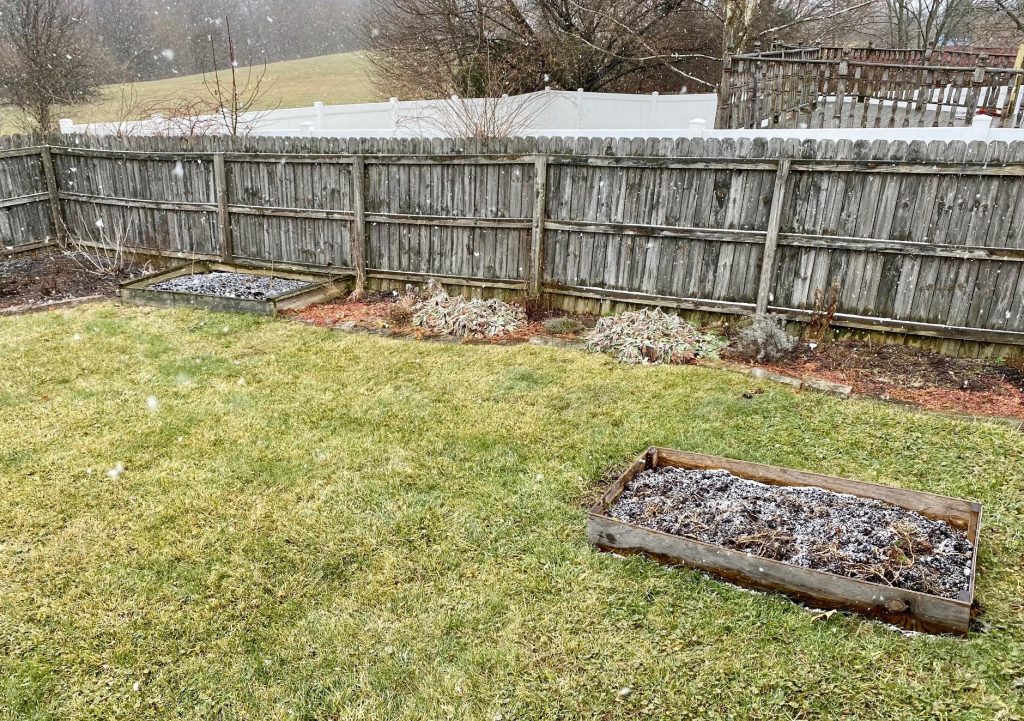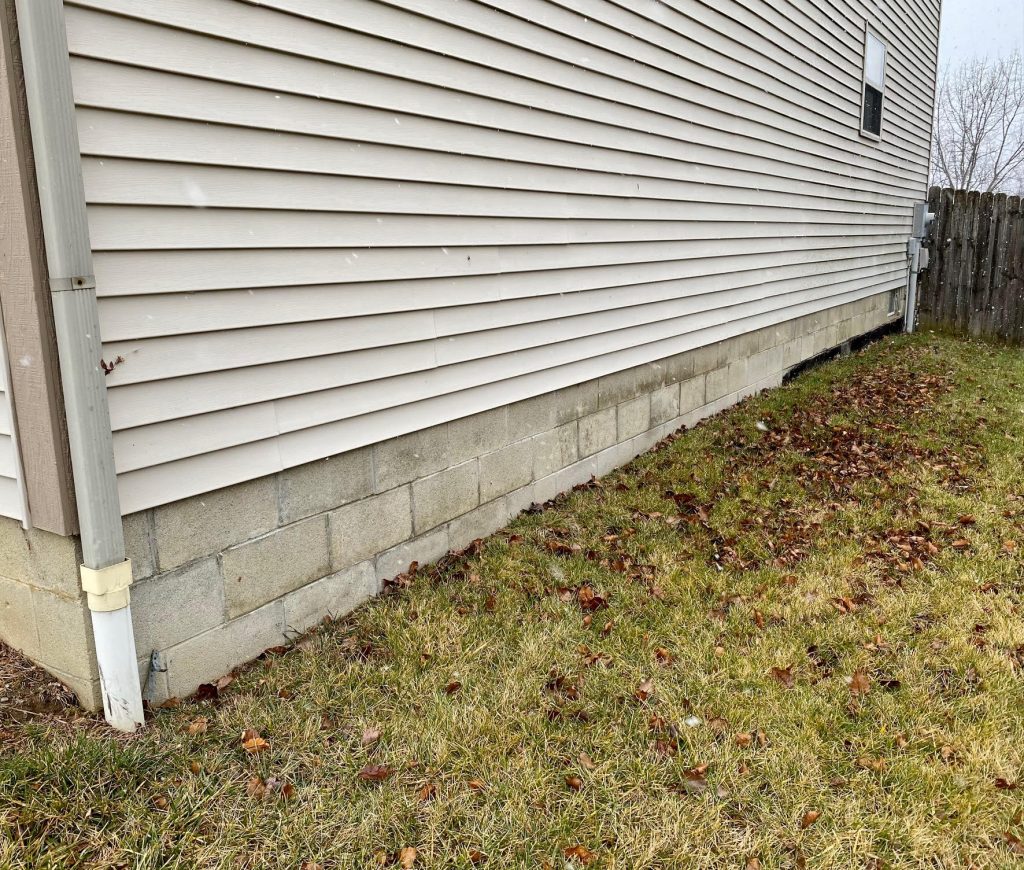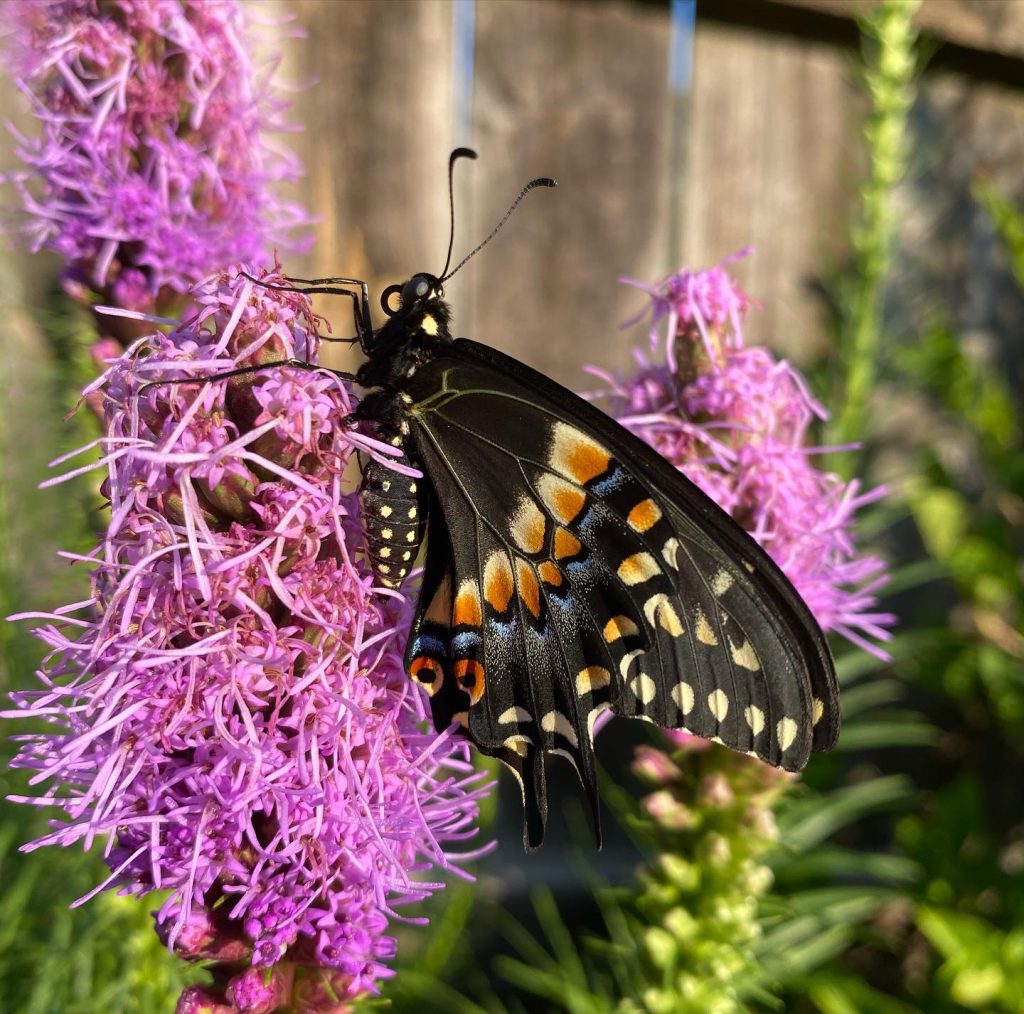It’s been snowing off and on here in Central Ohio for days. The snow isn’t sticking to the ground, but everything feels cold and damp, and we’ve all forgotten what the sun actually looks like. It’s definitely a good day to be indoors.
I spent some time on the floor today, covered in gardening books, colored pens, and my trusty notepad, looking ahead to springtime. In addition to the usual garden clean up I have in mind (like splitting up the lamb’s ear plants before they take over the entire yard), I want to tackle a few new landscaping projects.

January Flurries
I have three larger projects in mind for the spring: building two more raised beds for vegetables, turning one of the side yards into a wildflower bed, and fixing up the hellstrip out front by the road.
Project One: Raised Beds
Right now in the back yard, we have two raised beds for vegetables, in addition to a merry band of pots scattered around the deck, where I keep the herbs for easy access. The beds are (maybe?) three feet across, and six feet long. We have a crop of asparagus living in one, so there isn’t much room in that bed for anything else, and the other bed was built last year out of some leftover plywood I found in the garage.

Our first two vegetable beds
The beds live a little bit away from one another, but both spend the summer in full sun. I’d like to build two more this year (and by “I’d like to build,” I mean, “I’d like my husband to build”) so I’ll have more space for the massive number of seeds I plan to grow. My family makes salsa each year, and I simply cannot keep losing the battle for who grows the best tomatoes.
So, this is the first thing I’d like to tackle. It will be a cheap project, and shouldn’t take much more than a few hours to complete.
Project Two: Wildflower Bed
After the raised beds, I plan to combine my hatred for mowing the lawn with my desire to help out the local pollinator population by turning the barren wasteland on the side of our house into a wildflower bed. The space is aesthetically abhorrent right now, and I’ve decided this is the year I’m finally going to do something about it.

Clearly, we can do better than this.
In March, I plan to place some cardboard down over the grass to kill it. Then, I’ll turn the soil, maybe add some dirt to level things off a bit, and finally, in will go the wildflower seeds mix that I picked up this fall from the Ohio Prairie Nursery (I cannot recommend OPN enough for Midwest gardeners looking for native seeds and plants). I’ll edge the bed with some stone, add water, and wait for my mini prairie to start growing. Many native plant seeds here in Ohio require a cold period before they will wake up and start growing at all, so I hope to get the seed down well before our last frost date (which is usually in mid-May).
Project Three: Hellstrip Bed
I recently heard it described that the hellstrip (the patch of grass found between the sidewalk and the street in many a US yard) is called what it is because “no one knows what the hell to do with it.” Sometimes people will plant trees here, but other than that and the occasional mailbox, the area seems to just be patchy grass with not a lot going on, either for the local wildlife, or for anyone else.
We have two of these spaces, on either side of our driveway. I’ve been thinking about the best way to utilize the area for awhile now. This is the plan I’ve come up with (though it may change a few hundred times between now and April):

My design skills are unrivaled throughout the lands
On the one side of the driveway, for now, I’ll keep things simple. I want to put in a sugar maple tree. It’s native to Ohio, not too messy (since it will be right next to the street), and absolutely gorgeous in the fall, with fiery orange and red leaves.
The other side of the driveway will be a pollinator bed. The area gets lots of sun, and the soil there is pretty dry, so I chose plants that I knew would thrive in those conditions. I wanted plenty of native plants and flowers to make sure the wildlife in my area would be able to utilize them. I also wanted a pretty simple color scheme: greens and purples, with plants in bloom from early spring, through the end of fall. Finally, I wanted all of the plants to be perennials (which come back every year in the springtime), that require little to no maintenance. Here’s the list, with a bit of detail about each plant:
Meadowsage: Meadowsage is a great, deer-resistant butterfly magnet, with spikes of purple flowers that bloom from early summer to late fall.
Lamb’s Ear: My parents gave me some lamb’s ear from their garden a few years ago. It grows like mad, with silvery-green leaves and pretty purple flowers each summer. The bees love it, and I plan to move some from the backyard to the front to save on plant costs.
Prairie Blazing Star: Prairie Blazing Star is one of my favorite native flowers. The bees and butterflies are all over it when it flowers, in late summer, and the purple stalks of flowers bloom through the fall. This is a great flower to plant if you have clay soil.
Little Bluestem: Gardens just look good with grasses, and this Ohio native is high on my list of loves. It thrives in dry conditions, with silvery blue shoots of grass that get up to about 3 feet high. In fall, the grass turns a deep red.
Walker’s Low Nepeta: Though not an Ohio native, I can’t imagine having a garden without nepeta. It’s just the perfect plant. Nepeta (catmint) is super easy to grow. It’s hardy, loves the sun, and is resistant to most diseases and deer. The plant is covered in small purple blooms all summer and fall, and is a favorite for the bees in our yard. It smells amazing, looks whimsical, and has been known to attract the neighborhood cats (last summer, I accidentally summoned the local feline gang- they would take turns rolling around on the nepeta before staggering off, high as little kitty kites).
Irises: I am not sure what breed of irises that I have, but I plan to split some from the backyard to move out front. My irises came from my parents, who originally acquired theirs from my grandma’s family farm in Northeast Iowa. Each spring, they bloom with absolutely stunning pale purple flowers. It makes me think of my grandma every time I see them, and the shape of the flowers and silvery green-blue leaves adds some height and will match up with the bluestem perfectly.
Prairie Dropseed: Prairie Drop Seed is a compact little native Ohio grass. It doesn’t get very tall, and the grass blades are fine. Dropseed looks a bit feathery, like hair, with a bright green color that fade to gold in the fall. I thought it would be a nice texture against all the flowers.
Creeping Thyme: There are oodles of types of thyme around, but for a good ground cover in a sunny, warm spot, I love creeping thyme. It spreads nicely, attracts bees with its minty smell, and has really pretty purple-pink flowers in the summertime.

Black swallowtail on some prairie blazing star
While this is not my favorite time of year, I do like being able to take a step back, and plan for what’s to come. Researching new plants, and thinking up ideas for the springtime feels hopeful to me, like planting seeds. It’s a good reminder that soon, the sun will be out again, and I’ll be back in the garden, digging around and watching things grow. Happy gardening!
